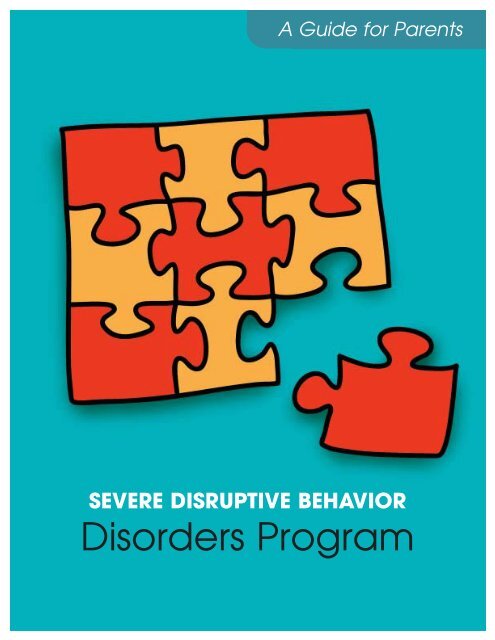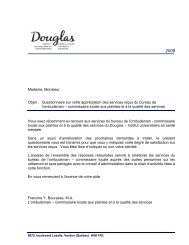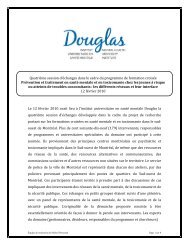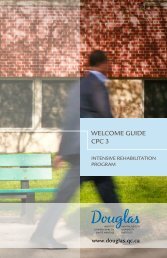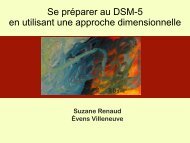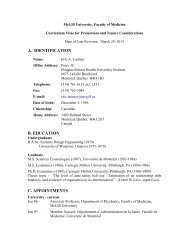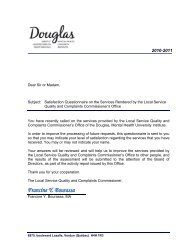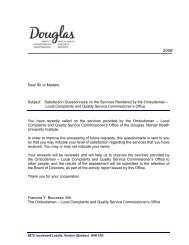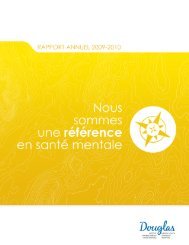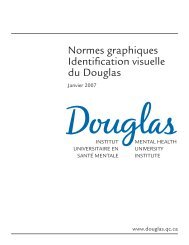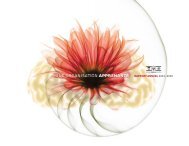Severe Disruptive Disorders Program - A Guide for Parents Child ...
Severe Disruptive Disorders Program - A Guide for Parents Child ...
Severe Disruptive Disorders Program - A Guide for Parents Child ...
- No tags were found...
You also want an ePaper? Increase the reach of your titles
YUMPU automatically turns print PDFs into web optimized ePapers that Google loves.
PART ITHE DAY HOSPITALTHE DAY HOSPITALAs you already know, our day hospital isan intensive family—and child—orientedtherapeutic milieu. That means that theefficiency of our therapy is based on theclose working relationship between ourteams and you, parents and caregivers.This section is designed to in<strong>for</strong>m youof the different treatments and researchprograms offered by the Day Hospital.Also, our day treatment program isaffiliated with the McGill University giventhat the Douglas Hospital is a McGillteaching hospital. Because yourinvolvement is very important, we offeryou an example of a typical day in ourDay Hospital. Lastly, we offer you theprogram’s rules and regulations.Individual therapyIndividual therapy sessions are a time <strong>for</strong> achild to share his/her thoughts and feelingswith a therapist, one-on-one, in a non-threateningenvironment. The aim is to help childrenunderstand themselves and what they’regoing through by looking at their past andpresent behavior patterns.Types of treatmentFamily therapyMilieu therapyMilieu therapy teaches children how to expresstheir feelings with words rather than though disruptivebehavior. We look at the child’s existingbehaviors and talk about setting limits andfinding effective coping behaviors. This type oftherapy helps children build their self-esteemby adjusting expectations to their actualabilities, while the group setting helps improvehow they relate to each other.Family therapy sessions usually include theentire family—so that everyone can get helpcoping with what they are experiencing. Youwill discuss things like the child’s symptoms aswell as when and how the problem may havestarted. <strong>Parents</strong> may be asked to adjust theirapproach, if needed. The sessions are veryuseful in identifying each person’s role withinthe family system.
5Occupational therapyPediatric occupational therapy helps childrenwith motor, behavioral, social and learning difficultiesreach their highest functional ability sothat they can do things that fulfill them—likeplaying, climbing, jumping, riding a bicycle,drawing, writing, etc. The occupational therapiststarts by assessing the developmental level ofthe child’s gross motor, fine motor, visual motor,visual perceptual skills and academic skills andthen works with the child to develop the skillsneeded to reach his/her highest level of functioning.Consultations and recommendationsare available to both parents and teachers.Pet therapyThe pet therapy uses animals to treat social,affective and/or cognitive problems. Therapistsbring in animals to help reduce anxiety andwithdrawal, increase focus, promote appropriatesocialization and empathetic responsesas well as provide emotional stability.Art therapySocial skills trainingSocial skills training helps children learn howto interact with others in a socially acceptableway, so that they may take part in the community.For best results, children work in smallgroups—usually with 6 children and twotherapists.The training takes a structural learning psychoeducationaland behavioral approachwhich includes:1. Modeling2. Role playing3. Feedback on the child role playing4. Feedback to the child on his useof training in daily activities.Art therapy offers children a way to expressthemselves creatively. Using a variety of materialsand play, art therapy helps children makesense of relationships and events in their lives,and adapt better to them. The children areseen individually or in small groups.Drama therapyOffered in individual sessions or in smallgroups, drama therapy brings drama andtheatre together with psychotherapy. <strong>Child</strong>renparticipate in games, stories and plays wherethey explore and even alter the roles theyand others play in their daily lives.
6Music therapyIn music therapy, children get to express theirthoughts and feelings through musical playand imagery play. In this type of therapy, theyare also taught to care <strong>for</strong> each other throughrelaxation. The children are either seen ingroups and/or individually, depending onavailability and needs.Our recreation and leisure program worksin collaboration with the physical educationprogram. It promotes physical activity throughstructured recreational activities in the gymand swimming pool as well as outings andspecial events. Through modified and lead-upgames, the program helps children learn tocooperate and work together as a team aswell as develop play skills and learn the rulesof different games. The ratio of two staff pergroup of six children is an ideal setting <strong>for</strong>children to increase their self-confidencethrough physical activity.Gym and swimOur physical education program is basedon the Quebec physical education curriculum,and it offers a variety of age appropriateactivities that encourage gross motor skillsdevelopment. The program focuses onincorporating locomotor skills into varioussports units in the gym and pool areasand we use the latest adapted physicaleducation research and instructionaltechniques to set goals <strong>for</strong> each child.What’s more, the program helps childrenimprove their socialization skills in smallgroup settings.Medical supervisionMedical rounds are done daily by the programpsychiatrist. At this time symptoms andmedication effects are evaluated. Discussionswith the team take place on a daily basis.
8A typical day—an overviewWhat are the goalsof our study?To determine whether Ritalin helps the childor not: We ask the children to participate in atwo-week medication trial where one week,they receive Ritalin, and another week, aplacebo (a pill that looks exactly like Ritalinbut is actually not real medication).Throughout the two weeks, we ask thechildren to per<strong>for</strong>m special attention tasksin order to evaluate if Ritalin helps enhancetheir per<strong>for</strong>mance and we also ask parentsand teachers to observe the children andcomplete short questionnaires about his/herbehavior during the medication trial. All thein<strong>for</strong>mation is gathered and the parents aregiven detailed results of the study.To determine what causes ADHD: To explorethe genetic and environmental componentsof ADHD, we ask parents to provide a familyhistory, in<strong>for</strong>mation about the pregnancyand delivery of the child, and the child’ssymptoms.To investigate factors that could influencethe child’s response to Ritalin. The childrencomplete a battery of neuro-psychologicaltests as well as tests to evaluate their psychologicaland academic functioning.The <strong>Severe</strong> <strong>Disruptive</strong> Behavior <strong>Disorders</strong><strong>Program</strong> is an intensive therapeutic milieu. Ourgoal during the stay is to help the child andhis/her family understand the child’s problemsand alleviate the child’s symptoms so thathe/she can function better within the community,home and school. The program offersa balance of treatment and academicactivities, and children are encouraged toparticipate in all activities, every day.A typical day begins around 8:30 a.m., whenthe children arrive at the designated schoolarea, by school bus. At this time, treatmentofficially begins. If there have been anyproblems on the bus ride over they are immediatelydealt with—with the child and thedriver. The children are then accompanied tothe Lyall Pavilion. Rounds are done early everymorning so that the physician can discuss anyissues with each child’s case manager.Throughout the day, children take part inMilieu group treatment activities designedto help them understand and manage theirthoughts, feelings and behavior. Daily Milieumeetings take place so that the case managersand children can deal with any issues orproblems that may have arisen the previousday, night or weekend, and nip them in thebud. Activities (like crafts, games or gardening)are geared to the child’s age group andare very effective in increasing their selfesteem,developing social skills and managingdaily frustrations. The time they spend withother children is very useful in helping themachieve their treatment goals as well as beingpersonally fulfilling. What’s more, they alsohelp the children understand their environmentand show them how they fit into it.Expressive therapies—such as art, music andpet therapy—enable the children to expressthemselves creatively.
9During the course of the week children alsotake part in individual sessions with a therapistand no other children around. These sessionsaddress the child’s specific needs and mayinclude occupational or even speechtherapy.Every day, children eat lunch in their respectivetreatment rooms with their case managerwho uses this time to help children cope withthe events of the morning, learn social skillsand relax.When lunch time finishes at 12:45, the childrenare ushered to the school portion of their day.This academic time takes place in anotherbuilding so that children differentiatebetween treatment and school and learnwhich behaviors are appropriate <strong>for</strong> each.This also helps the children understand thatthe teacher is in charge of their schoolingand the case manager is responsible <strong>for</strong> theirclinical treatment. Although the children areat school, the case managers are availableto assist if any behavior problem shouldcome up. At 3:00 PM the staff accompanythe children to the school bus area.A typical weekArrival8:30Arrival8:30Arrival8:30Arrival8:30Arrival8:30Medicalrounds9:00Medicalrounds9:00Medicalrounds9:00Medicalrounds9:00Medicalrounds9:00Milieu Meeting9:30 – 10:30Milieu Meetings9:30 – 10:00Milieu Group9:30 – 10:00Milieu group9:30 – 10:00Milieu group9:30 – 10:00Milieu Groups10:30 – 11:15Social Skills10 00 – 11:00Gym & Swim10:00 – 11:00Drama Therapy10:00 – 10:45Gym & Swim10:00 – 11:00ArtTherapy11:15 – 12:00Milieugroup11:00 – 12:00OccupationTherapy11:15 – 12:00Milieugroup11:00 – 12:00Weekly-Review11:15 – 12:00Lunch12:00 – 1:00Lunch12:00 – 1:00Lunch12:00 – 3:00Lunch12:00 – 13:00Lunch12:00 – 1:00School12:45 – 3:00School12:45 – 3:00School12:45 – 3:00School12:45 – 3:00School12:45 – 3:00Departure3:00 – 3:15Departure3:00 – 3:15Departure3:00 – 3:15Departure3:00 – 3:15Departure3:00 – 3:15N.B.One or more times a week on individual therapy session is scheduled throughout the day.Family therapy sessions scheduled at a time that’s convenient <strong>for</strong> parents and therapist.
10Policies and regulationsDress codeParent availabilityWe ask that all parents provide us with a telephonenumber where they can be reached incase of an emergency and parents need tomake themselves available at all times to pickup their child, if the situation arises.Please dress your child appropriately <strong>for</strong> theweather and season. Boots must be wornduring the winter months, and children mustbring in a bathing suit, gym shorts, joggingpants and running shoes <strong>for</strong> various activities.T-shirts with inappropriate messages on themare not acceptable and the child will haveto change when they arrive on the premises.Lunch and snack<strong>Parents</strong> must provide a nutritious meal plusa snack <strong>for</strong> their child, every day. We do notallow the children to have any junk foodlike soft drinks, chips, or chocolate bars,throughout the day.No smoking policySmoking is not permitted on or nearthe premises.We recommend sandwiches made withcheese, meat, peanut butter, etc. vegetablesand fruit <strong>for</strong> snacks and juice or milk to drinkas part of a well-balanced meal. If your child<strong>for</strong>gets to bring lunch you will be contacted,but if you cannot bring it be<strong>for</strong>e lunch time,we will provide one and parents will becharged <strong>for</strong> it.Contact with otherchildren in the programoutside program hoursWe do not encourage the children to socializeor contact each other outside of programhours. However, we understand that ultimatelythe decision is yours.
11Articles from home<strong>Child</strong>ren are allowed toys, games, booksor other items to keep them occupiedwhen travelling on the bus. Expensive toys(ex. Game Boy) are not allowed. At school,these items will remain in their bags and maybe used only with the teachers’ permission.Aggression or acting outTime-outWhen a child’s behavior becomes disruptive,time-out may be called. The child will beasked to leave the ongoing activity and goto a separate area <strong>for</strong> a quiet discussionbetween the child and staff.Separation RoomA room used <strong>for</strong> unmanageable behaviorand/or an opportunity <strong>for</strong> a child and staffmember to have a calm discussion.Gifts (Christmas, etc.)Gifts to take home are made during theprogram activities, but gifts from home arediscouraged.RestrainingWhen a child is out of control, staff membersmay restrain him/her by holding the child untilhe is calm and able to communicate with thestaff. The technique we use is a basket holdwhere the child’s arms are crossed in frontof him/her in a standing or sitting position.Special activitiesSpecial activities (like skating or a BBQ)are held throughout the year <strong>for</strong> the childrento socialize and you may be asked to helpfund them.Physical aggressionPhysical aggression towards staff is not toleratedand it will result in immediate expulsionfrom the program. The psychiatrist will then askyou and your child to return to meet with theteam where it will be decided if the child willbe permanently expelled from the program.Aggression towards peers is not tolerated,either. If it occurs three times, the child willbe expelled. You and your child will then beasked to return to meet with the team atthe request of the psychiatrist.
12If your child becomes ill while at the hospital,you will be asked to pick him/her up so thathe/she may get proper care. Please provideemergency telephone numbers and thename of a person responsible <strong>for</strong> your childif you cannot be reached.Dangerous weaponsNo weapons are permitted and if any are discoveredthey will be confiscated immediatelyand the child will be sent home. You and yourchild will then be asked to return to meet withthe team to discuss the incident as well aswhether or not your child will be permittedback in the program.Should emergency treatment be required,you will be asked to meet your child at thetreatment centre.Destruction of propertyDestruction of property is not accepted andparents will be responsible <strong>for</strong> paying <strong>for</strong> allrepairs and replacements.Family therapyattendanceFamily therapy is scheduled once a week,and the whole family’s participation is obligatoryin order <strong>for</strong> the child to remain in ourprogram. The therapist and family will set amutually convenient date and time, and bothparties will have to in<strong>for</strong>m each other of anycancellations 48 hours in advance.VaccinationsThe parents present vaccination bookletupon registration in the program. For themost part, parents are responsible <strong>for</strong>their children’s vaccinations. Vaccinations<strong>for</strong> hepatitis B or other specific vaccines(<strong>for</strong> infection outbreaks) are done throughthe on-site CLSC in the Lyall Pavilion andthe program nurses coordinate the process.When this occurs, all relevant in<strong>for</strong>mationand <strong>for</strong>ms will be sent home and you willbe asked <strong>for</strong> authorization. On the dayof the vaccination, children must bringtheir vaccination booklets in with them.Absence and illnessIf, <strong>for</strong> any reason, your child cannot attendthe program, you are required to notify thecase manager be<strong>for</strong>e 8:30 a.m. If you cannotreach us, please be sure to leave a messagedetailing the reason <strong>for</strong> the absence (sickness,appointment, etc.).
13School re-integrationand follow-upDischarge from the day hospital is consideredpart of the treatment process, and it is theprogram psychiatrist’s responsibility. Whenthe team feels that the child is ready to bedischarged from the day hospital, the parentsand team work together to develop anappropriate school reintegration plan.Usually, the child is integrated into schoolprogressively—<strong>for</strong> example, they may goto school two days in the first week, three daysin the second week and five days in the thirdweek. If reintegration occurs in September,the child is re-integrated full time.Medical transfer toGeneral Practitioner orPediatrician after dischargefrom the programAll children must have a family doctor orpediatrician. After the child has completedthe program, the child will be referred backto the family doctor or pediatrician who willbe responsible <strong>for</strong> the child’s care andprescription renewal. Upon discharge, aprescription <strong>for</strong> three months of medicationwill be given to the parents. During that time,the parents are expected to make anappointment with their doctor or pediatricianto continue treatment.The case manager initially works with theschool staff to facilitate the re-integrationprocess, and the school may contact thehim/her to discuss managing potentialdisruptive behavior problems. Similarly,teachers may contact the teacheraffiliated with the program to discussacademic issues.Follow-up after dischargeAfter a child has been discharged fromthe program, you may make arrangements<strong>for</strong> family and individual therapy sessionsto continue. What’s more, case managersare available <strong>for</strong> consultations with thecommunity, school or family, and theirservices will continue to be offered until itis felt that they are no longer necessary.
PART IIANGRIGNON SCHOOLWe recognize the importance of workingclosely with the clinical team to ensurethat our program will benefit childrenthroughout their stay. And we alsostrongly believe in the development of achild’s thinking and learning processes,as well as academic skills. That’s why theDay Hospital’s <strong>Severe</strong> <strong>Disruptive</strong> Behavior<strong>Disorders</strong> <strong>Program</strong> (SDBDP) works withteachers from the Lester B. PearsonSchool Board (LBPSB) to provide schoolservices and support <strong>for</strong> elementaryschool age children. We offer threeEnglish and two French classes, andclassrooms are located in the FinleyPavilion.Vision statementWe, the members of the Lester B. PearsonSchool Board community comprising students,parents, teachers, professionals, support staff,administrators and commissioners, value:–A respect <strong>for</strong> self, <strong>for</strong> each other, <strong>for</strong> ourdiversity and <strong>for</strong> our environment.– Striving <strong>for</strong> excellence by maximizingthe potential of each individual andby promoting a commitment to lifelonglearning.–The fostering of responsible citizenship,cooperation and a strong sense ofcommunity.– The importance of a caring, nurturingand safe environment that is responsiveto the needs of all.– An atmosphere of openness, honesty,integrity and accountability.School structure and time– Students attend school <strong>for</strong> 2 1/2 hoursa day.– Academic programs are based onindividual needs.– Different learning styles are taken intoconsideration.– Special attention and programmingmeet the needs of students with identifiedlearning disabilities.– The curriculum is based upon the educationre<strong>for</strong>m, with the focus being on the developmentof cross-curricular competencies.Theme materials are used to teach conceptsand skills.
15Parent/Teacher nightsThere are four parent/teacher nights in theacademic year. Following the reporting sessionsin November, February and April, parents willbe invited to meet with the teachers to discusstheir child’s progress.Pedagogical daysA number of professional days are designatedby the school board in conjunction with theteachers’ union. At the beginning of eachacademic year, the school office will makethese days known to the parents of childrenin the program.RegistrationUpon registration to SDBDP, parents are askedto bring a birth certificate, eligibility certificate(<strong>for</strong> English language instruction, where applicable)and the student’s most current reportcard—all of which the school will use toprocess the child’s registration.Individual EducationPlan (IEP)An IEP will be written to reflect the objectivesof each student in the program. The IEP iswritten within 60 days of the child enteringschool. Returning students to the programin September will have an IEP written within30 days. This IEP will accompany the first reportcard. At that time, parents will be asked ifthey want to provide feedback or if they wishto add/delete any of the identified objectives.Report cardsThere are four <strong>for</strong>mal reporting sessionsduring the school year: November, February,April and June.TransportationTransportation to the day hospital (SDBDP)and school program is arranged STRICTLYthrough the school office, as part of the registrationprocess. Any difficulties with transportationshould be reported to the school secretaryat 762-3005.School bus behaviorStudents receiving three disruptive behaviorwarnings from the transportation companywill be suspended from transportation <strong>for</strong>one school day. <strong>Parents</strong> will be notified of thesuspension and the day it will occur so thatthey may make alternate arrangements. Thesuspended child can still attend treatmentand school programs, but he/she must betransported by the parent.
16OutingsDuring every school year there are threeeducational outings. There is a nominal fee<strong>for</strong> each outing, but if a parent is unableto pay it, alternate arrangements can bemade by contacting the school office.School suppliesStudents attending the program are notcharged <strong>for</strong> school supplies, but teacherswill notify parents if additional suppliesare needed.HomeworkHomework is assigned at the discretion of thestudent’s teachers. Students in cycle 1 seldomget homework until after the Christmas break.Students in cycles 2 and 3 will get homeworkat the start of the program, depending ontheir behavior at the time of admission toschool.àHomework chartsEach student will have a homework chart.<strong>Parents</strong> are asked to review their child’shomework with them and initial it uponcompletion.Safe school policyThe Lester B. Pearson School Board believesthat everyone in our community is entitledto a safe, secure and respectful environmentfree of all <strong>for</strong>ms of harassment and violentbehavior. This policy can be read in its entiretyby visiting the web site www.lbpsb.qc.caThe teaching staff will follow this policy unlessotherwise stipulated by the clinical/educationteam.
17Classroom behaviorOur mandate is to help students learn how tofunction within a classroom setting. If a childcannot behave appropriately, a teacher mayask him/her to leave the classroom. A casemanager may be brought in if the child needsadditional help controlling his/her behavior.Physical aggressionPhysical aggression towards the teachingstaff is not tolerated. If it occurs, the policyas defined by the clinical program will befollowed.School reintegrationand follow-upWhen the psychiatrist—along with the team—decides to discharge a child from the dayhospital SDBDP, the head teacher will arrangea placement conference with the receivingschool board. School board professionals,members of the clinical and educationalteam, parents and the child (if applicable) willall be asked to attend. At the meeting, theappropriate integrative process <strong>for</strong> the childwill be shared. Usually, the student is integratedinto school gradually—first with two days aweek, then three, then five, but students dischargedin September are integrated fulltime.Teachers from the receiving schools areencouraged to contact the teachers affiliatedwith the program to discuss the child’s academicprogress level and classroom behaviors.At the discretion of the principal, teachersmay be released to meet with the receivingschool’s teaching staff.Behavior chartsEach student will have a school behaviorchart that reflects his/her daily classroombehavior. <strong>Parents</strong> are asked to reviewthis chart and initial it every day.
ANNEXE IGLOSSARYTHE DAY HOSPITALAttention Deficit/Hyperactivity Disorder (ADHD)<strong>Child</strong>ren have 2 or 3 main symptoms:● inattention● impulsiveness● hyperactivityOppositional Defiant Disorder (ODD)These children often:● lose their tempers● argue with adults● actively defy or refuse to comply with requests or rules● deliberately annoy people● blame others <strong>for</strong> their mistakes or misbehavior● are touchy or easily annoyed● feel angry and resentful● feel spiteful or vindictiveConduct DisorderThese children have symptoms of ODD as wellas other symptoms like:● aggression to people and animals● destruction of property● deceitfulness or theft● serious violations of rulesReferenceKAPLAN, Harold I., Benjamin J. SADOCK. Synopsis of Psychiatry :Behavioral Sciences/Clinical Psychiatry, Eighth Edition,Lippincott Williams & Wilkins, New York, 1998.
ANNEXE IISUPPLY LISTTHE DAY HOSPITAL●●●●●●●●●●●●●●●●1 set of coloured pencils (wood)1 set of markers (washable)1 pad of construction paper1 pair of scissors (round edge)1 comb1 tooth brush1 tube of tooth paste1 plastic glass or cupBathing suitGym shortsJogging pantsRunning shoesBasic school suppliesBackpackPencilsEraser
ANNEXE IIIUSEFUL NAMES AND NUMBERSTHE DAY HOSPITALTreatment CentrePhysician Case manager Family therapist Individual therapist General number: (514) 762-6131, ext. 2113Angrignon SchoolTeacher General number: (514) 762-3005


